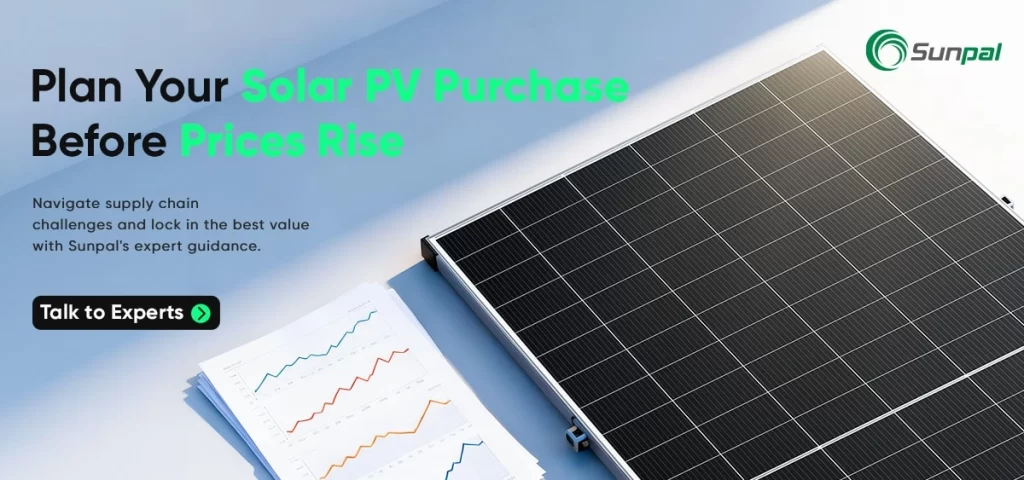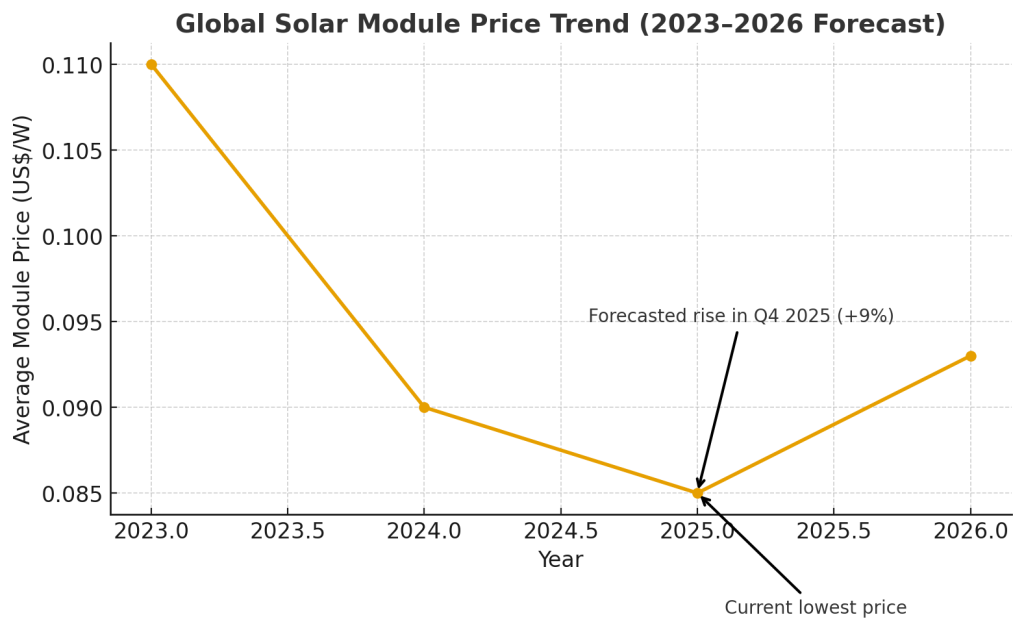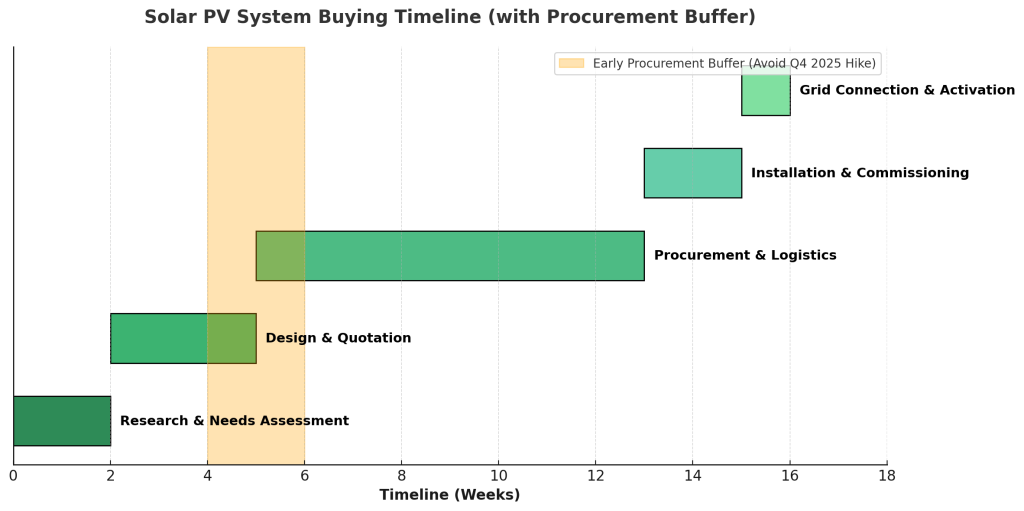
Market Snapshot: Why Timing Matters in Solar PV Procurement
In 2024–2025, solar module pricing saw unprecedented lows—but that window is closing. Industry forecasts now warn of sharp increases ahead. For example, Wood Mackenzie projects a ~9% rise in global solar module costs in Q4 2025 due to policy shifts and production cuts.
At the same time, utilization rates at Chinese solar factories have dropped significantly (to around 55-60 %) as capacity restructuring kicks in.
This tightening of supply while demand remains strong means the time to plan your solar project is now—not later.
Current Supply Chain Pressures & Price Signals
Supply Chain Stressors
- Polysilicon constraints — consolidation in upstream raw materials is driving up its cost.
- Policy shifts - China's removal of a 13 % VAT export rebate for modules/storage from Q4 2025 is pushing international shipping costs and end-user prices higher.
- Trade & tariff risk - for solar projects sourcing from Southeast Asia or exporting internationally, policy changes (e.g. U.S. tariff enforcement) can alter your procurement cost path.
- Factory utilisation declines - Tier-1 and Tier-2 manufacturers have lowered output as part of a market recalibration to avoid oversupply.
Price Trends at a Glance
| Métrique | Recent Level | What It Means |
| TOPCon module prices (China) | ~$0.085 / W | Near lowest levels seen—but rising soon |
| Global module price momentum | Up slightly in Q2–Q3 2025 | Indicates bottoming of prices |
| Forecast price rise | +9% expected in Q4 2025 | Procurement delays may cost you |
Chart 1:

These trends mean that buyers who delay could pay significantly more—both in equipment cost and opportunity cost (delayed energy savings / payback period).
Optimised Buying Timeline: Protect Yourself from Delays & Cost Surges
Here's a practical timeline you can follow to manage solar procurement risks in 2025–2026:
| Phase | Duration | Key Activities & Risk Notes |
| Research & Needs Assessment | 1–2 weeks | Energy audit, site feasibility, budget planning |
| Design & Quotation | 2–3 weeks | Choose module / inverter types, get multiple quotes |
| Procurement & Logistics | 4–8 weeks | Order early to buffer shipping delays, for “lock-in” pricing before Q4 2025 hikes |
| Installation & Commissioning | 1–2 weeks | On-site work once hardware arrives |
| Grid Connection & Activation | ~1 week | Final inspections, utility approval, monitoring setup |
Recommendation: begin procurement at least 2 months before any planned install date. For a project targeting completion in Q1–Q2 2026, start ordering equipment by Nov 2025 or earlier to avoid price increases and shipping delays.
Chart 2:

Mitigation Strategies: How to Shield Your Purchase from Volatility
To reduce the risk of delay or unexpected cost increases, apply these strategies:
- Fixed-price procurement agreements — lock in pricing with suppliers before policy change deadlines.
- Diversified sourcing — mix suppliers (local and international, Tier-1 certified) to reduce reliance on any single region subject to policy shifts.
- Modular / phased installations — design your PV system so you can install core elements now, expand later (e.g. battery storage add-on).
- Stay informed on trade & incentive changes — government incentives, tariff reviews, and renewable energy policy amendments can shift your economics overnight.
- Work with experienced EPC / system integrator (like Sunpal) that owns clear visibility on supply lead times, compliance, and vendor relationships.
These risk-mitigation steps help reduce the effect of both delivery delays and sudden price shifts.
Why Sunpal Is Your Best Partner Under Today's Conditions
At Sunpal, we understand that procurement delays and price changes are no longer theoretical risk—they're real and urgent. Here's how we help our customers:
- We maintain strategic supplier relationships with Tier-1 manufacturers to minimize lead-time uncertainties.
- Our procurement planning tools track forecasted module / inverter price trends so we can advise clients on best order timing.
- We offer turnkey design-to-installation services so that buffer times between design, procurement, and delivery are optimised.
- We monitor policies, tariffs and supply-chain indicators continuously to alert clients on when to move fast.
By partnering with Sunpal early, you can avoid “last-minute rush” premiums and ensure your system gives you the best ROI over its lifetime.
Outlook: What to Expect Beyond 2025
- Prices likely to rise further in 2026 — the +9 % forecasted for Q4 2025 may be only the beginning. Continued consolidation and rising upstream costs suggest ongoing upward pressure.
- Greater adoption of battery-storage bundling — as costs stabilise, many new PV systems will include storage. Planning now for storage integration may reduce retrofitting costs later.
- Potential policy shifts — new import/export rules, sustainability certifications (e.g. carbon footprint), or local mandates could influence not just cost but eligibility for incentives.
- Higher ROI for early movers — those who order ahead of price hikes benefit from longer periods of lower operating cost and faster payback.
Your best strategy? Prioritise timing. Plan early. Execute decisively.
Conclusion & Call-to-Action
The solar PV market is moving fast. Supply chain delays are real. Price volatility is looming. But if you plan with the right strategy and timeline, you can secure better costs, reduce risk, and maximise returns.
